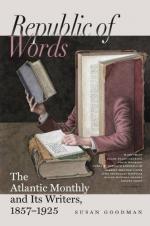My theme being the Wild Apple, I will merely glance at some of the seasons in the annual growth of the cultivated apple, and pass on to my special province.
The flowers of the apple are perhaps the most beautiful of any tree’s, so copious and so delicious to both sight and scent. The walker is frequently tempted to turn and linger near some more than usually handsome one, whose blossoms are two-thirds expanded. How superior it is in these respects to the pear, whose blossoms are neither colored nor fragrant!
By the middle of July, green apples are so large as to remind us of coddling, and of the autumn. The sward is commonly strewed with little ones which fall still-born, as it were,—Nature thus thinning them for us. The Roman writer Palladius said,—“If apples are inclined to fall before their time, a stone placed in a split root will retain them.” Some such notion, still surviving, may account for some of the stones which we see placed to be overgrown in the forks of trees. They have a saying in Suffolk, England,—
“At Michaelmas time, or a little
before,
Half an apple goes to the core.”
Early apples begin to be ripe about the first of August; but I think that none of them are so good to eat as some to smell. One is worth more to scent your handkerchief with than any perfume which they sell in the shops. The fragrance of some fruits is not to be forgotten, along with that of flowers. Some gnarly apple which I pick up in the road reminds me by its fragrance of all the wealth of Pomona,—carrying me forward to those days when they will be collected in golden and ruddy heaps in the orchards and about the cider-mills.
A week or two later, as you are going by orchards or gardens, especially in the evenings, you pass through a little region possessed by the fragrance of ripe apples, and thus enjoy them without price, and without robbing anybody.




